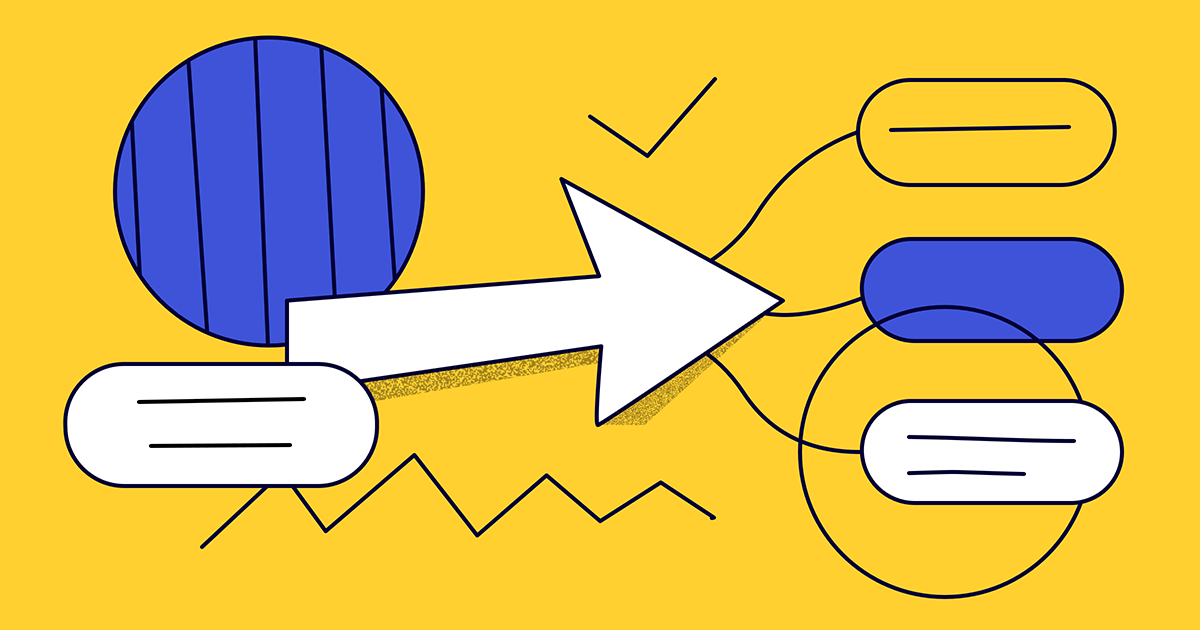At Miro, we’ve built an innovation workspace that helps companies embrace digital transformation, manage remote teams, and think visually. As a result, they can speed up internal processes and delight their customers.
Because of our background, we’re curious about how leading companies, UX consultants, and professionals around the world approach building products that create value for their customers.
We asked Csaba Hazi, a user experience design expert, co-founder of Webabstract, and author of Seven Step UX: The Cookbook for Creating Great Products, to share valuable UX advice with our readers. In this article, he outlines his key steps for aligning user experience goals with your business goals, how to build a strong UX portfolio, and, ultimately, a successful company.
Why do you need to align your UX strategy with your business goals?
Before we get to Csaba’s insights, let’s clarify why it’s important to align UX strategy with business goals:
- Create a shared vision. Everyone is on the same page when your UX strategy aligns with your business goals. From business leaders to UX designers, everyone knows what work needs to happen and the direction you’re heading.
- Support business growth and development. Aligning goals across your business helps your business succeed. Think about it: How would the business ever develop if all of the departments were working toward unrelated goals? There’d be no clear direction, which would make it hard to grow. By aligning your design goals with your business goals, you give your business a better chance of success.
- Put user-centered design at the heart of the business. Your UX strategy is all about how you can offer an amazing user experience and improve customer satisfaction. Align this strategy with your business goals, and you’ll make sure that customers are at the forefront of business growth. They get a better digital experience, and your business is more likely to grow. It’s a win-win.
Csaba Hazi: 4 methods to align UX strategy with your business goals
Now that we know the importance of aligning business and UX goals, let’s see what Csaba has to say about how to make it happen.
#1. Be clear about your business goals and objectives
“In my experience, most products suck for two reasons: A) there’s no (good) process behind them and B) team communication is too close to Klingon,” says experienced design consultant Csaba Hazi.
To align the goals and metrics and help designers be more effective, you need to collaborate. Csaba insists on having a workshop to solve this problem. The workshop should help designers think about business goals while developing a new product.
“They might not have the right framework for it, or they are not involved in the process, or they simply feel that it’s someone else’s responsibility (e.g., the product manager’s),” explains Csaba.
However, it’s crucial for anyone who plans, designs, or develops digital services to understand the underlying business goals. “I look at business goals as I look at UX,” Csaba says. “UX is not something that’s one person’s responsibility; everybody is responsible for the experience the product creates in the user.”
In other words, every project team member has ownership of the product. “It results in a much happier and more efficient team and, not to forget, a far better product,” Csaba observes.
When organizing a meeting for UX designers to learn about business objectives, Csaba advises keeping it simple. Get together with the product leaders, stakeholders, designers, and developers, and start by writing down the most important questions.
- Target users — Who are the users? Who do you target? You can create a user persona to figure this out.
- User needs — What are the problems that you want to solve through the product? Again, creating a user persona will help you identify customer challenges and pain points.
- Product goals — What do we want to achieve? Be specific (for example, get subscribers or increase the number of people completing the onboarding process). You can also use the SMART goals framework to make sure your goals are clear, concise, and measurable.
At this stage, there are a lot of different frameworks and approaches you can follow. “I prefer the User Centered Business Canvas (it is designed to map out every important aspect of the product, business, and users) because it’s focused on the user (target group, goals, fears) and on the business (goals, how you make money, marketing channels) at the same time,” argues Csaba.
Furthermore, it’s designed for UX work:
- Existing solutions — A good first step is to do initial research about what’s out on the market already. This will give you a better understanding of your competitors and the marketplace.
- Early adopters — These are the people who’ll come to your user tests and are happy to do interviews with you. They’re also loyal customers, so it’s important to find this audience group and keep them happy.
- User fears — These are what you have to address with your communication. Show users that your product or service can solve any of their challenges and overcome their fears.
“Another thing I like to suggest to product teams is to create a so-called playbook. It shows how the team (or company) builds products, from the idea to design to implementation,” adds Csaba.
It has to feature the key steps, people involved, challenges and solutions. It’s like a customer journey for work. “Yes, UXers! You are free to use your own tools to hack your own teamwork!” he laughs.
#2. Create user personas to keep everyone on the same page
When building a new product, you need to choose the right features. “Let’s rephrase this: you need to find out which features the users need,” explains Csaba. When you find out what your potential customers need, you’ll be able to meet their needs with the right features.
However, Csaba remarks that assumptions can influence our perception of user needs. For example, you think that your customers will use your app on the go. Until you validate this theory, it’s just an assumption. You need to conduct research to back up your theories and get to the bottom of what your customers want.
Researchers can use user personas to identify assumptions, validate them, and bring in more information. “Personas are great for marketing communication as well; for example, I like to include a section dedicated to the fears of the users, because for marketers and even sales reps, that means they know what they have to address in their communication,” adds Csaba.
For UX designers, in particular, thinking about the paying user leads to thinking about the business. “When you create personas, you will definitely have one dedicated to the paying users,” says Csaba.
“For example, recently, I was working on a tennis program management tool, and when we created the persona for the owner (who is the paying user), it was a complete game-changer,” remarks Csaba.
The process helps Csaba’s clients explore the persona’s fears, motivations, and goals. Based on this information, they made an informed decision about which features to add to their product.
“On the website, we knew what to say, what fears to address, and how to turn features into benefits. If you are into marketing, you must have heard this: talk about benefits over features.” While it’s great advice, Hazi is sure that you need a deep understanding of the product and the users to be able to do this.
#3. Align user needs with your business goals
There’s often no alignment between user needs and business goals. Why? Because most people don’t know how to align them.
“Designers often have fuzzy concepts about business goals. Maybe they are not involved, just executing,” Csaba observes. And most of the time, a product team is just building what the stakeholders need instead of serving real user needs.
“Once you start listening to the users and getting the company on the same page about what you want to create, things get much easier. In my practice, it’s rare that the business goals and user needs do not align well,” assures Csaba.
When you’ve modified your User Centered Business Canvas and created user personas, Csaba’s advice is to think about what you want as a business.
For example, let’s say you’re designing an onboarding process. What’s the business goal behind onboarding? What do we want the users to do? How do the users want the onboarding process to happen? You need to be clear about what users want and how this aligns with your business goals.
A good way to tackle this is to outline the customer journey. Csaba says that it’ll help you think about how your customers move through the buying experience. It’ll show you the bigger picture, outlining how user needs and business goals tie into the system.
#4. Organize design review meetings
A design review meeting evaluates product designs based on specific criteria. It helps cross-functional teams discuss their ideas and make sure their designs are heading in the right direction.
It’s also a chance for other team members to give feedback on the designs, which is a crucial part of an effective design process. It shows the product designer what’s working well and what needs improvement.
“The design review is an exercise for the team to provide meaningful feedback to the designers,” Csaba says. “To make sure every standpoint is covered, we set up roles for everybody. Each role observes the designs from a different perspective.”
Here are the roles (which are also color-coded):
- White looks at the facts
- Black looks for problems and potential risks (try our RAID log templates)
- Yellow looks at what’s good about the designs
- Green looks for ways to improve the product
Here’s how to get started with your own design review meeting:
Invite Team Members
Book a meeting room for 90 minutes, or schedule an online meeting if you’re running the session virtually. Invite the design team, developers, and stakeholders to join.
Set The Roles
Assign each person a role in the meeting to make sure you cover all the key areas. The best approach is randomly setting the roles (white, black, green, yellow). You can learn a lot from trying out different roles each time.
Present the Designs
Start by describing the goals of the project and the product, then show the participants your designs. Don’t explain too much about the designs. Only provide the necessary information to get them started, and they can form their own opinions without being influenced by your perspective.
Work Individually For 25 Minutes
Everyone looks at the designs individually and collects remarks based on their roles. Csaba prefers to use a spreadsheet to collect everybody’s feedback. That way, you’ll be able to work simultaneously. You can also use Miro’s digital workspace to collect and review ideas.
Discuss AND Prioritize!
When time’s up, go through and discuss each comment. This gives you the chance to cover all the feedback, especially the most important design elements like what the problems are and how you can improve them. The team has to decide the priority for each comment and whether they’ll implement it or discard it. Using a brainstorming session for this part of the process is particularly helpful.
Use Miro to create a successful UX strategy
Csaba is sure that these techniques can be effective and enjoyable. “When you think about the product, think about the business. This will make designing and creating a product much more fun!”
Following Csaba’s advice, you can ensure your UX goals align with business growth and development.
If you’re wondering how to plan and manage the entire process, take a look at Miro. Our virtual platform is the perfect place for teams to collaborate, share ideas, and create a shared vision. We also have over 300+ templates for you to choose from, all of which are customizable. Sign up for free today!
ABOUT THE speaker
Csaba Hazi
Csaba Hazi is a co-founder and UX expert at Webabstract and the best-selling author of Seven Step UX: The Cookbook for Creating Great Products. To learn more about Csaba’s work, you can follow him on Facebook and Instagram or subscribe to his YouTube channel.
Profile
Webabstract
Webabstract is a UX/UI agency based in Budapest, Hungary, and St. Louis, Missouri. It specializes in UX design and research, and mobile application development.
Founded: 2015
Team: 9 people
Founders: Csaba Hazi, Daniel Knaust, David Dorosz



